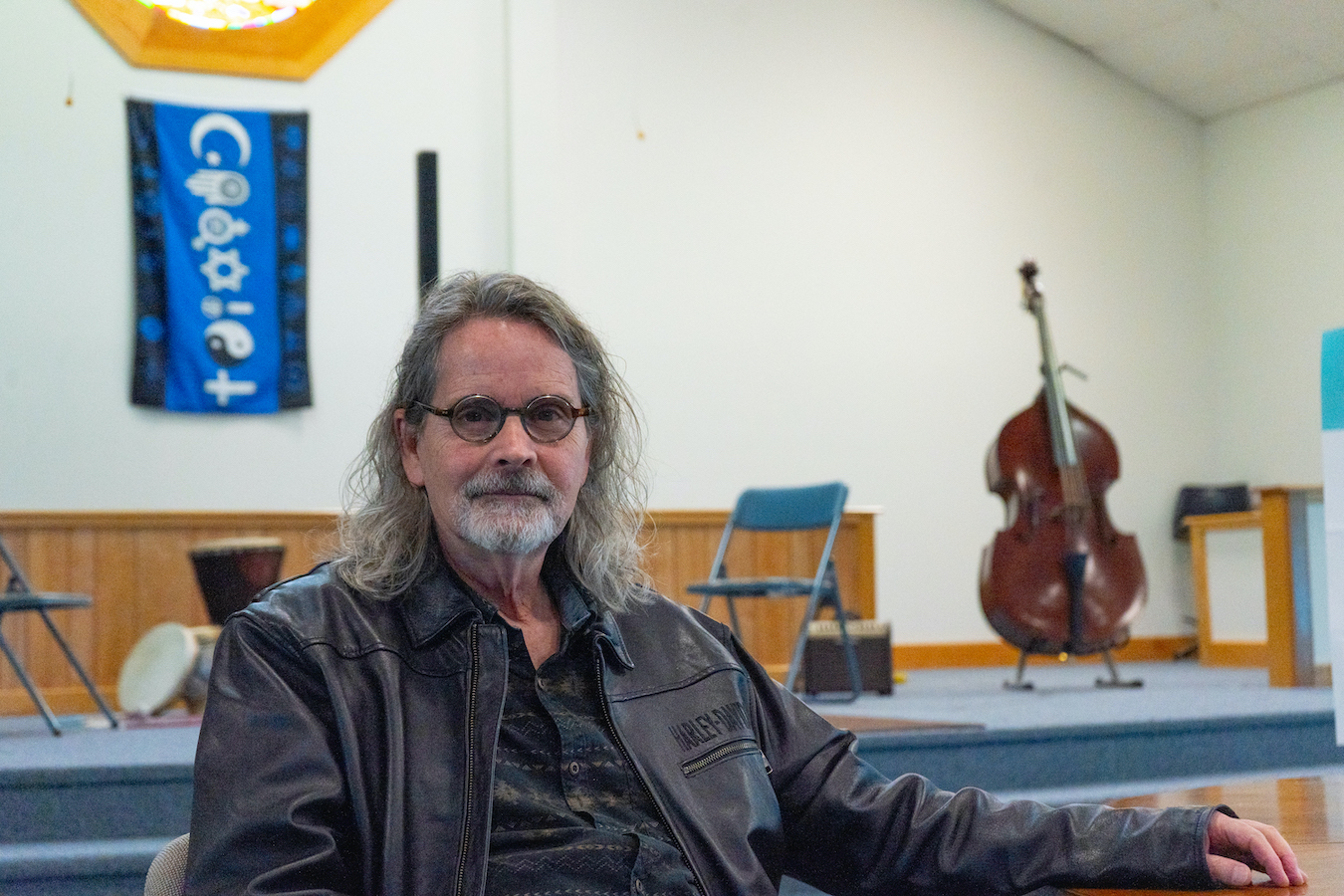Rick Clayton strode through an empty church, past the platform where he used to preach, between the pews he’d love to sell but can’t give away.
To make the former Harmony Baptist Church feel less Baptist, Rick displayed a turtle shell and other pagan objects throughout the sanctuary. Under the stained glass window portraying Jesus in the Garden of Gethsemane, he hung a “COEXIST” flag.
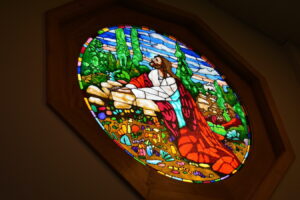
Rick, though not a Christian anymore, sees Jesus as a utopian figure. “I feel like I’m following Christ more deeply than I ever could have dreamed by doing this,” he said. | Photo by Haley Miller
“So everyone knows this is not just a Christian place,” he said. “This doesn’t even have to be a religious place, you know, for the patients that come in here.”
When he looked around, he envisioned the perfect place for people to come to die.
The walkout basement, where kids once gathered for Sunday school, could become a living space. He curtained off the east corner, making room for a hospital bed and medical supplies. He arranged pullout couches so family and friends could sleep close by.
He wanted to create spaces of solace. He brought in massage tables, essential oil diffusers, and Tibetan singing bowls; he designated rooms for meditation and art therapy.
Rick gestured to a window that peered into an adjacent room. “This is the baptistry,” he said, “which I’m pushing to be a hot tub.”
A ‘good death’
Rick isn’t interested in being anyone’s pastor anymore. He found that his brand of social Christianity, the progressivism that underlay every sermon he taught, tended to clash with the more conservative churches where he landed.
That was true of Harmony Baptist Church in Brown County, Indiana. Most of the congregation left because they didn’t like his politics, but a small cohort stayed to support him in his next project: a sanctuary for the dying.
Outside of ministry, Rick is a chaplain at SouthernCare hospice in Bloomington. His work with patients convinced him the dying population was isolated, exploited, and overmedicated.
“I see the elderly and the dying population as largely forgotten,” Rick said. “And if they’re not forgotten, they’re capitalized on to make money off their infirmities.”
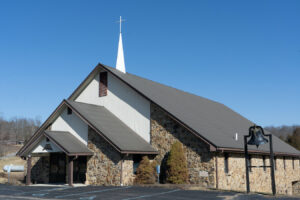
Harmony Palliative Arts Collective will open in the building that used to be Harmony Baptist Church. In starting the collective, Rick wants to make end-of-life care more accessible. | Photo by Alayna Wilkening
Rick and Harmony’s board decided to transform the church into Harmony Palliative Arts Collective, a place for patients to live out their final weeks with their loved ones and receive non-medical end-of-life services.
Rick hopes to open this summer and offer the furnished space to one patient and their family at a time. He will provide the dying with palliative music, art therapy, aromatherapy, therapeutic touch, and spiritual support. All of Harmony’s services, made possible through grants and donations, will be free.
In Brown County and across rural Indiana, chronically ill and dying people have limited access to comfort care focused on maintaining quality of life.
More than six million Hoosiers live with one or more chronic illnesses, according to a 2022 study, but insufficient funding, a lack of providers, and geographical barriers stand in the way of the comfort care they need.
The COVID-19 pandemic exacerbated the problem, said Nasreen Lalani, co-author of the study and a professor in the Purdue University School of Nursing.
“A participant told me they closed down palliative care services during COVID, when it was the most needed,” Lalani said. “They did not have the funding.”
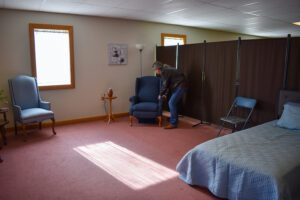
Rick arranges a recliner in the room where the patient will sleep. Grants and donations, like the chair, have sustained the Harmony project. | Photo by Haley Miller
When rural Indiana residents can’t access comfort care, they are less likely to experience a “good death.” A 2012 analysis in the American Journal of Hospice and Palliative Medicine defined a good death as one that avoids unnecessary suffering, maintains a family presence, manages pain, and upholds the patient’s dignity.
Harmony Collective is a hospice chaplain’s attempt to create the conditions for more good deaths.
Experiences with death
Rick remembers the bad ones.
In over a decade of hospice work, the worst part was witnessing the terror. He thought back to one of his patients, a 98-year-old man in Bloomfield who was dying of cancer.
The man had gone to his Apostolic preacher for guidance. The preacher told the dying man that cancer was the manifestation of sin.
The man clung to life for weeks, Rick estimated, tormented by the question of what sin remained in his life.
“For twelve years now, I’ve been mopping up those kind of messes,” Rick said.
He thought, too, about his own memories of death.
He was a touring rock musician with no involvement with Christianity in 1990, when he and his wife lost their baby. Shortly before Clarissa Elaine was born, they learned she would die within minutes.
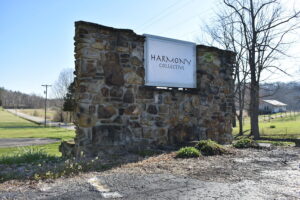
Harmony Collective is in rural Brown County. Rural Hoosiers have trouble accessing comfort care because of a variety of barriers, including geographical and financial, according to a 2022 study. | Photo by Haley Miller
The doctor, Rick observed, didn’t know how to talk to two grieving parents. She said they could always have another baby, and maybe it would help to think of Clarissa Elaine as a mass of cells.
His daughter’s death triggered an existential crisis that brought him to his first Christian church service. He came to see Jesus as a utopian figure, an uplifter of the poor, marginalized, and forgotten.
“I thought, here’s the original pagan hippie,” Rick said. “I bought in.”
He enrolled in Bible college, went to seminary, and bounced around Indiana churches for a couple decades. He jokes that he destroyed every church he went to.
He disputed modern Bible translations. He challenged the writings of Paul the Apostle, such as his claim that women should submit to men and be silent in church. He believed Paul undermined Jesus’s egalitarian message.
Most congregations felt he was too political. Rick hoped he would find a church that embraced his progressive Christianity, but it never happened.
Then, in 2011, his world changed.
While exercising at the YMCA, Rick collapsed. Sticky platelets, the doctors said. Right coronary artery blockage. For ten minutes, Rick was clinically dead.
During that time, he had an out-of-body experience. He floated above the scene to watch the responders resuscitate him, he said, and he felt surrounded by something greater than himself and religion. It was an indescribable peace.
If it weren’t for that moment, Rick said, he would be an atheist.
“I cannot deny that when I was gone, there was something out there, and it wasn’t Christian and it wasn’t Muslim,” he said. “It was much broader. I should say, my faith got bigger after that experience.”
Those ten minutes set Rick on a new course. He left his church at the time and became a hospice chaplain. He made palliative music a fixture of his practice by playing guitar, harp, and cello for patients to help them “unbind” and let go of life.
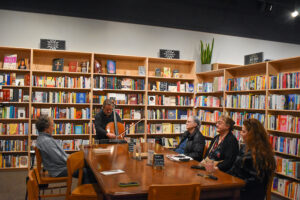
Rick gives a demonstration of palliative music at Death Cafe, a group that meets monthly to have an unstructured conversation about death. Rick plays palliative music for patients to help them transition from life to death. | Photo by Haley Miller
Recently, he began hosting a chapter of Death Cafe, a gathering that encourages people of all ages to come talk about death. Rick often begins the discussion with one of the songs he plays for patients.
And now, Harmony, a project that combines his artistic abilities with his calling to guide people through the end of life. Rick sees it as the most meaningful work he can do.
“Being struck with fear when you’re dying is one of the most horrible things you can go through,” Rick said. “If someone dies at peace, I’ve done my job.”
A group effort
On a bright morning in March, seven visitors converged on Harmony Collective: one architect, two documentary filmmakers, one journalist, two friends, and one friendly neighborhood dog that tried to slip in the front door.
Rick isn’t making Harmony happen alone.
First, the architect — the building was changing from commercial to residential, which required a sprinkler system. But Harmony didn’t have the infrastructure to support sprinklers, so Rick would have to appeal to the state to deviate from zoning laws, and that required architectural plans, so … the architect.
Next, the documentary filmmakers and the journalist — publicity had burned Rick before (a magazine story set off the events leading to the sprinkler dilemma), but media coverage gave him a platform to speak about everything wrong with the death industry.
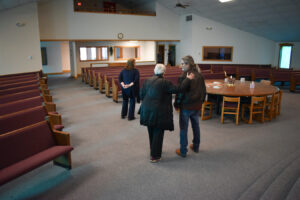
Lida Baker, one of Harmony’s board members, congratulates Rick on how far the project has come. “It’s a blessing for me, I’ll tell you,” she said. “Who knew, all those years ago when you came here, that this would be what it will be?” | Photo by Haley Miller
Then, the friends — Lida and Terre stopped by to donate a reclining armchair. Terre imagined it could be a small comfort to the families spending long nights there. She laughed appreciatively when she saw Rick had carried it in and nestled it in the corner. “Goodbye, old friend,” she said.
Lastly, the dog — no one knew exactly what his story was.
The death industry
Rick belongs to a multi-decade movement challenging the way American society handles death. Beginning with hospice in the 1970s, advocates pushed for comfort and quality of life rather than medical intervention at any cost.
“There’s the old saying that if you are a hammer, everything looks like a nail,” said Dr. Robert Stone, medical director of the palliative care program at IU Health Bloomington Hospital. “If you are an intensive care doctor, then you have all these skills, and it’s really easy to want to keep going.”
The antibiotic revolution in the 20th century radically changed physicians’ attitudes toward death, Stone said. They came to see death as the enemy.
This era, according to A Social History of Dying by Allan Kellehear, marked a shift from in-home to in-hospital deaths. As death became more expensive and less humane, hospice emerged to fill a need for care that treated the whole person.
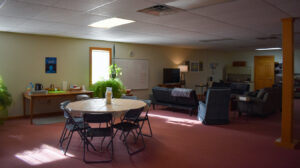
In the common area, families will have access to a kitchen, laundry, and full bath. | Photo by Haley Miller
Rick’s vision of holistic care minimizes drugs in the dying process. He said patients can continue using prescription pain medication, but they can also turn to him for non-medical pain management.
His specialty is palliative music, played during “unbinding,” the moment of transition from life to death. Palliative music features simple, improvised melodies, such as a continuous low C on a cello.
When the patient nears death, Rick switches from grounding songs like “Amazing Grace” to the defamiliarizing tones. It signals to the dying person that it’s time to let go.
“I developed this idea of dosing people with music,” Rick said. “Understanding what particular keys and tempos did to the body physiologically.”
Rick wants to make these services widely available. The death industry, he said, leads people to believe they must spend thousands of dollars for a good death, which adds stress to an already painful process.
As an ex-Christian, he appreciates the irony of the project taking shape in a church. But he believes he’s following the teachings of Christ now more than ever.
“I do like the stained glass, the cynic in me,” he said, looking up at the round window depicting Gethsemane. “This is the famous passage of Jesus praying in the garden while everyone else is sleeping.”
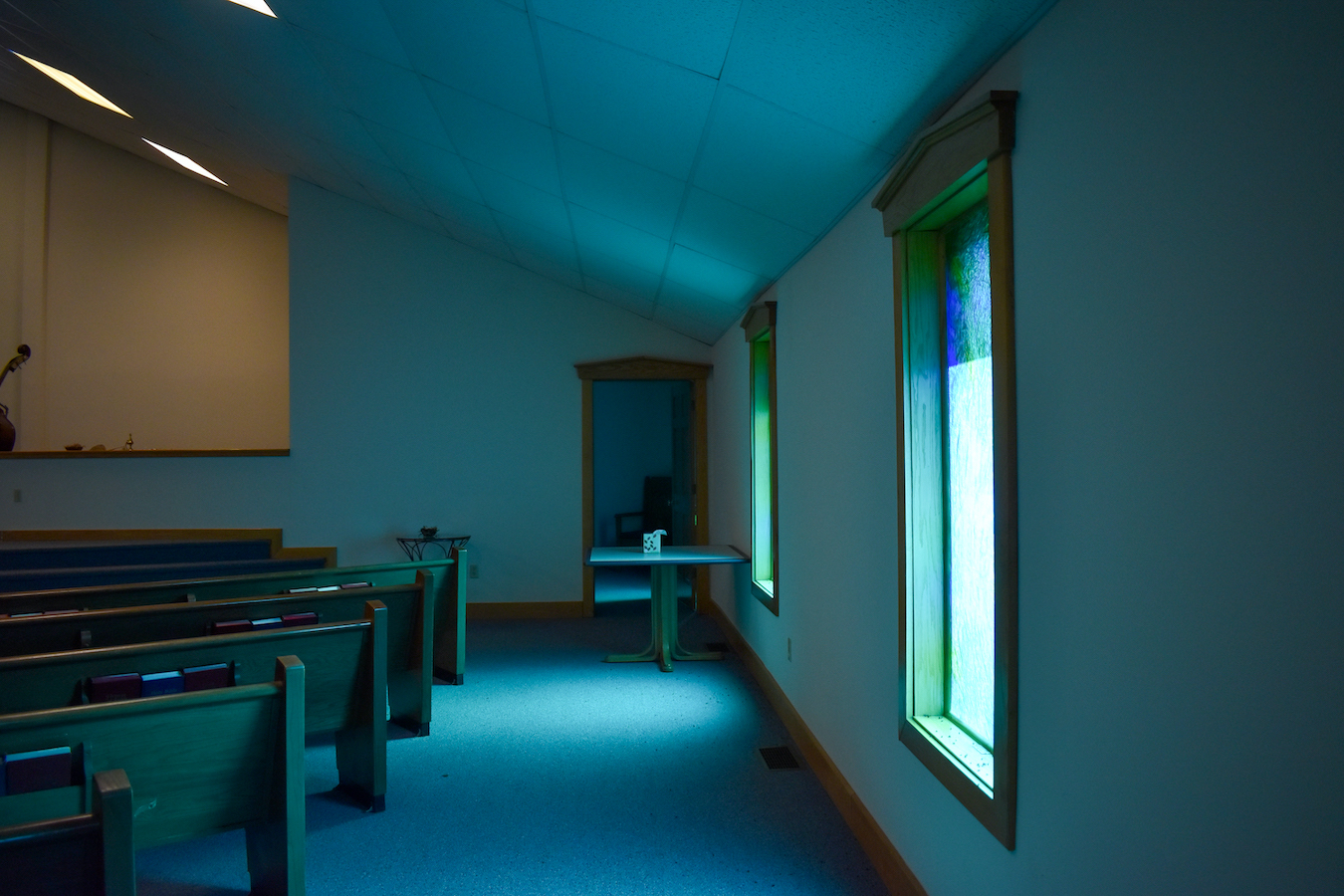
Rick plans to use the upper floor of Harmony as a support space for families. Different rooms serve the purposes of art therapy, meditation, massage, and musical performance. | Photo by Haley Miller
A soulful effect
The room at the hospice facility was stuffy, too warm for a well person. The dying man lay in bed with the sheets tucked in and his feet peeking out.
Sitting low to the ground, the bed looked almost miniature. A cushioned pad waited on the floor in case he fell. A black-and-white movie, an old Western, played in the background, perhaps for familiarity. Maybe just for the noise.
The door opened, and Rick stepped in with his guitar case. He crossed the room and without hesitation got to his knees to meet the man at eye level.
“Hey, buddy,” said Rick, touching his shoulder. “How are you doing, my friend?”
The man stirred from sleep as Rick asked him how he was feeling and if he was in pain. Yes, pain, the man rasped. His hands shook uncontrollably.
“You don’t worry about having to talk or anything,” Rick said. “I brought that guitar you like — well, at least you liked it last time, right?”
He unlatched his guitar case, dragged over a chair, and reminded the man he didn’t have to stay awake during the music. Just relax.
Then, Rick began to play. The song was “Dark Was the Night, Cold Was the Ground,” the blues masterpiece that borrowed its title from an old English hymn called “Gethsemane.”
Rick didn’t care so much for the religious connection; he mostly appreciated the artistry. His resonator guitar gave the song a twangy and soulful effect. A swampy sound, he called it.
With each exhale, the dying man seemed to sink deeper into his bed. The tremors in his hands came less frequently now.
The man continued to fade between sleep and semiconsciousness. After several minutes, the music stopped, and Rick set down his guitar.
“Was that OK?” he asked.
The man didn’t answer, but his hands were still.

